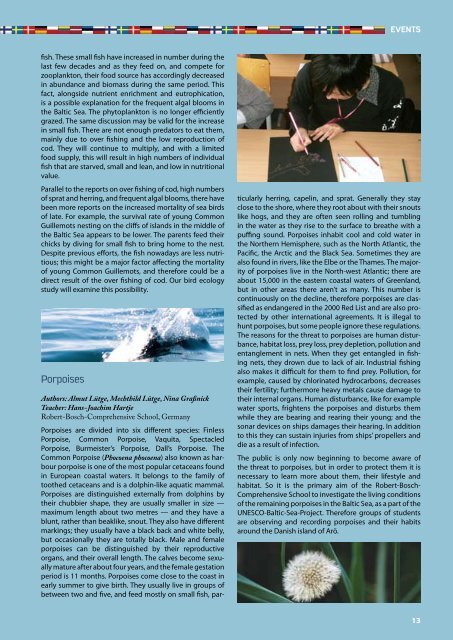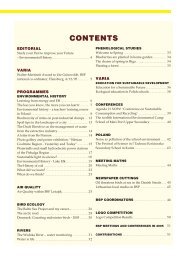newsletter_2008_1.pdf - 5.84 MB - The Baltic Sea Project
newsletter_2008_1.pdf - 5.84 MB - The Baltic Sea Project
newsletter_2008_1.pdf - 5.84 MB - The Baltic Sea Project
You also want an ePaper? Increase the reach of your titles
YUMPU automatically turns print PDFs into web optimized ePapers that Google loves.
fish. <strong>The</strong>se small fish have increased in number during the<br />
last few decades and as they feed on, and compete for<br />
zooplankton, their food source has accordingly decreased<br />
in abundance and biomass during the same period. This<br />
fact, alongside nutrient enrichment and eutrophication,<br />
is a possible explanation for the frequent algal blooms in<br />
the <strong>Baltic</strong> <strong>Sea</strong>. <strong>The</strong> phytoplankton is no longer efficiently<br />
grazed. <strong>The</strong> same discussion may be valid for the increase<br />
in small fish. <strong>The</strong>re are not enough predators to eat them,<br />
mainly due to over fishing and the low reproduction of<br />
cod. <strong>The</strong>y will continue to multiply, and with a limited<br />
food supply, this will result in high numbers of individual<br />
fish that are starved, small and lean, and low in nutritional<br />
value.<br />
Parallel to the reports on over fishing of cod, high numbers<br />
of sprat and herring, and frequent algal blooms, there have<br />
been more reports on the increased mortality of sea birds<br />
of late. For example, the survival rate of young Common<br />
Guillemots nesting on the cliffs of islands in the middle of<br />
the <strong>Baltic</strong> <strong>Sea</strong> appears to be lower. <strong>The</strong> parents feed their<br />
chicks by diving for small fish to bring home to the nest.<br />
Despite previous efforts, the fish nowadays are less nutritious;<br />
this might be a major factor affecting the mortality<br />
of young Common Guillemots, and therefore could be a<br />
direct result of the over fishing of cod. Our bird ecology<br />
study will examine this possibility.<br />
Porpoises<br />
Authors: Almut Lütge, Mechthild Lütge, Nina Graßnick<br />
Teacher: Hans-Joachim Hartje<br />
Robert-Bosch-Comprehensive School, Germany<br />
Porpoises are divided into six different species: Finless<br />
Porpoise, Common Porpoise, Vaquita, Spectacled<br />
Porpoise, Burmeister’s Porpoise, Dall’s Porpoise. <strong>The</strong><br />
Common Porpoise (Phocoena phocoena) also known as harbour<br />
porpoise is one of the most popular cetaceans found<br />
in European coastal waters. It belongs to the family of<br />
toothed cetaceans and is a dolphin-like aquatic mammal.<br />
Porpoises are distinguished externally from dolphins by<br />
their chubbier shape, they are usually smaller in size —<br />
maximum length about two metres — and they have a<br />
blunt, rather than beaklike, snout. <strong>The</strong>y also have different<br />
markings; they usually have a black back and white belly,<br />
but occasionally they are totally black. Male and female<br />
porpoises can be distinguished by their reproductive<br />
organs, and their overall length. <strong>The</strong> calves become sexually<br />
mature after about four years, and the female gestation<br />
period is 11 months. Porpoises come close to the coast in<br />
early summer to give birth. <strong>The</strong>y usually live in groups of<br />
between two and five, and feed mostly on small fish, par-<br />
EvENTS<br />
ticularly herring, capelin, and sprat. Generally they stay<br />
close to the shore, where they root about with their snouts<br />
like hogs, and they are often seen rolling and tumbling<br />
in the water as they rise to the surface to breathe with a<br />
puffing sound. Porpoises inhabit cool and cold water in<br />
the Northern Hemisphere, such as the North Atlantic, the<br />
Pacific, the Arctic and the Black <strong>Sea</strong>. Sometimes they are<br />
also found in rivers, like the Elbe or the Thames. <strong>The</strong> majority<br />
of porpoises live in the North-west Atlantic; there are<br />
about 15,000 in the eastern coastal waters of Greenland,<br />
but in other areas there aren’t as many. This number is<br />
continuously on the decline, therefore porpoises are classified<br />
as endangered in the 2000 Red List and are also protected<br />
by other international agreements. It is illegal to<br />
hunt porpoises, but some people ignore these regulations.<br />
<strong>The</strong> reasons for the threat to porpoises are human disturbance,<br />
habitat loss, prey loss, prey depletion, pollution and<br />
entanglement in nets. When they get entangled in fishing<br />
nets, they drown due to lack of air. Industrial fishing<br />
also makes it difficult for them to find prey. Pollution, for<br />
example, caused by chlorinated hydrocarbons, decreases<br />
their fertility; furthermore heavy metals cause damage to<br />
their internal organs. Human disturbance, like for example<br />
water sports, frightens the porpoises and disturbs them<br />
while they are bearing and rearing their young; and the<br />
sonar devices on ships damages their hearing. In addition<br />
to this they can sustain injuries from ships’ propellers and<br />
die as a result of infection.<br />
<strong>The</strong> public is only now beginning to become aware of<br />
the threat to porpoises, but in order to protect them it is<br />
necessary to learn more about them, their lifestyle and<br />
habitat. So it is the primary aim of the Robert-Bosch-<br />
Comprehensive School to investigate the living conditions<br />
of the remaining porpoises in the <strong>Baltic</strong> <strong>Sea</strong>, as a part of the<br />
UNESCO-<strong>Baltic</strong>-<strong>Sea</strong>-<strong>Project</strong>. <strong>The</strong>refore groups of students<br />
are observing and recording porpoises and their habits<br />
around the Danish island of Arö.<br />
13





